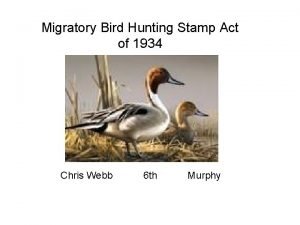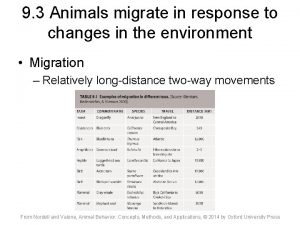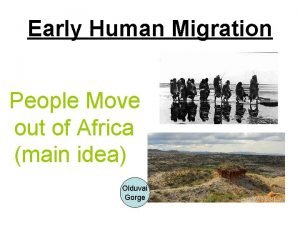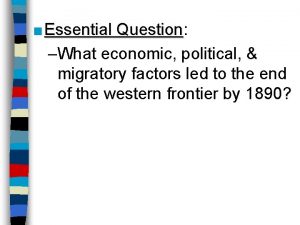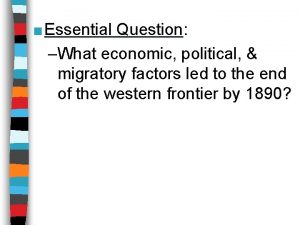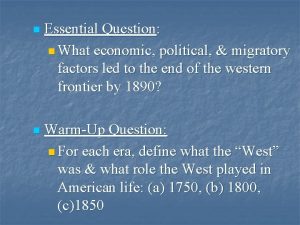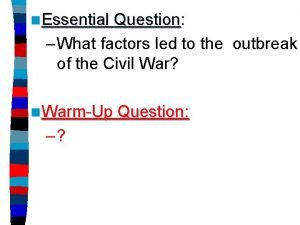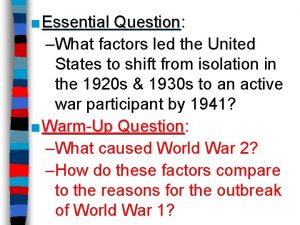Essential Question Question What economic political migratory factors


























- Slides: 26

• Essential Question: Question – What economic, political, & migratory factors led to the end of the western frontier by 1890?

America After the Civil War: 1870 -1900 Ranching, Mining, & Farming Industrialization & Urbanization Reconstruction & Rise of Jim Crow Segregation

America in the Gilded Age: 1870 -1900 The South: South By 1877, the South was recovering from the Civil War but was no longer forced to “reconstruct”

The “New South”? Sharecropping We won’t discuss much about the South in this unit because, when Reconstruction ended in 1877, few significant economic or political changes took place until the 1940 s “Jim Crow” reigned supreme as whites legally segregated the South into 2 distinct societies

America in the Gilded Age: 1870 -1900 The North: North Experienced a “ 2 nd Industrial Revolution, ” mass immigration, & urbanization

American industry grew Railroads, steel, &&urbanization oil companies formed America’s first monopolies

America in the Gilded Age: 1870 -1900 The West: West Manifest Destiny continued after 1865 as miners homesteaders, & ranchers headed West

The United by 1890 North Washington Montana Idaho States Dakota Established new states & closed the frontier by 1890 Colorado Wyoming South Dakota

. . but this came at the expense of Native Americans Western raw materials fueled eastern factories

Settlement of the West

Western Pull Factors • Mining, cattle, and farming attracted people West.

Irish workers made up a large percentage of laborers on the eastern section Chinese workers made up a large percentage of laborers on the western leg 1 st transcontinental railroad connected the west coast to eastern cities in 1869

The Transcontinental Railroad In 1870, RR companies developed the 1 st time zones to better schedule the RR system; the US would not adopt time zones until 1918

Railroad Construction, 1830 -1920

Crushing the Native Americans

The Plains Indians In 1865, 2/3 of all Indians lived on the Great Plains Their culture was dependent upon the buffalo & the horse Tribes of several 1, 000 people were subdivided into bands of 100 s which made it difficult for the U. S. to negotiate treaties

Searching for an Indian Policy • Before the Civil War, the West was “one big reservation” – The Indian Intercourse Act (1834) forbade whites from entering “Indian country” without a license

Searching for an Indian Policy • But…rapid Western expansion in the 1850 s brought a new Indian “concentration policy” with distinct boundaries for each tribe “as long as the waters run and grass grows”

Searching for Policy “Kill and scalp all, an big. Indian and little” • Concentration did not last as whites Congress investigated & ignored these boundaries: Chivington’s attack condemned – Sand Creek Massacre (1864)—Col John Chivington attacked 700 sleeping Indians in CO after a peace agreement was signed – Sioux War (1865 -1867)—gold miners wanted a Bozeman Trail (across Sioux hunting grounds) to connect mining towns; Sioux murdered 88 U. S. soldiers

Searching for an Indian Policy • In 1867, the U. S. formed the Indian Peace Commission : –The Ended Bozeman Trail plans discovery of gold in South Dakota – Made “small army reservations” in the Dakota & & led a Sioux of 2, 500 to ambush Oklahoma territories kill Lt Col Custer & his 197 soldiers • Few Native Americans settled into these Black soldiers in theset U. S. army called “Custer’s Last Stand” off demands reservations peacefully: “buffalo soldiers” were used to fend for revenge among Americans – Red River War (1874) off Indian attacks in the West –The Little. U. S. Big Horn (1876) army was ordered to stop – Wounded Knee Massacre Sioux “ghost dances”(1890) & machine gunned 200 men, women, & children

The. Indian End and of Tribal Life “Kill the save the man” —Richard Pratt, founder Carlisle • In 1871, the U. S. adopted its 4 thof. Indian policy: Assimilation – U. S. citizenship was offered to all Indians who farmed, lived away from their tribe & “adopted the habits of civilized life” – Dawes Severalty Act in 1887 offered farms (160 acres to families & 80 to men) & the protection of U. S. laws

The End of Tribal Life • The final blow to Indian culture came with annihilation of buffalo: – Began with the construction of the transcontinental RR in 1860 s – From 1872 to 1874, 3 million buffalo were killed each year

1 hunter = 100 buffalo per day

The Final Fling • In 1889, Congress responded to demands to open the Oklahoma Territory to white settlement • On April 22, 1889, about 100, 000 “Boomers” & “Sooners” flooded into the last “Indian land” – White migrants claimed 2 million acres in Oklahoma homesteads – Moved out Creeks & Seminoles

Lands. Indian Lost by. Reservations Native Americans (1894) Today

Conclusions: The End of the Frontier • By 1890, the western frontier ended –Miners, ranchers, & cowboys flooded West at the expense of Indians who With no more West were restricted smaller & smaller A continuation of to to conquer, where antebellum reservations would American “Manifest Destiny” expansion go next? –Westerners were commercially connected to Eastern markets but would grow increasingly frustrated by the economic & political concentration of power in the East
 Migratory bird hunting and conservation stamp act
Migratory bird hunting and conservation stamp act Migratory aptitude is greater for
Migratory aptitude is greater for Migratory behavior
Migratory behavior Migratory aptitude is greater for
Migratory aptitude is greater for Migratory paths of early humans
Migratory paths of early humans Characteristics of lipids
Characteristics of lipids Costa level 2 questions examples
Costa level 2 questions examples Political economic
Political economic Which political cultural and economic characteristics
Which political cultural and economic characteristics Economic forces behind management thought
Economic forces behind management thought Chapter 3 political and economic analysis
Chapter 3 political and economic analysis Chapter 3 political and economic analysis
Chapter 3 political and economic analysis Economic growth vs economic development
Economic growth vs economic development Economic growth and development
Economic growth and development Economics unit 1 lesson 2 difficult choices
Economics unit 1 lesson 2 difficult choices External factors affecting tesco
External factors affecting tesco Under armour mission statement
Under armour mission statement Essential question for figurative language
Essential question for figurative language Formula hipotenusa triangle rectangle
Formula hipotenusa triangle rectangle Essential question generator
Essential question generator Pythagorean theorem essential questions
Pythagorean theorem essential questions Figurative language essential questions
Figurative language essential questions Essential question about identity
Essential question about identity Use context clues in figuring out the meaning
Use context clues in figuring out the meaning What is the essential question in cornell notes
What is the essential question in cornell notes Essential questions definition
Essential questions definition Essential questions for multiplication
Essential questions for multiplication
